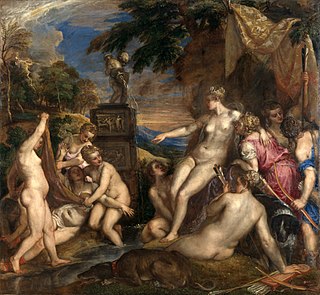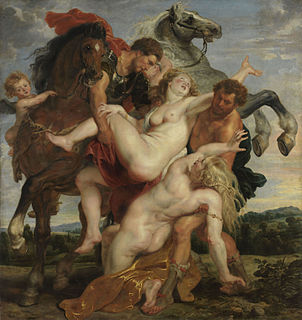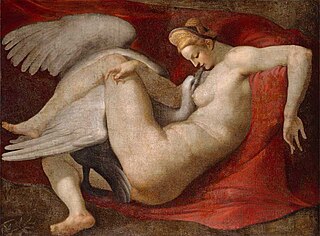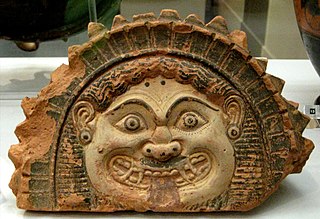 W
WRape is a common topic in history and mythology. A list of notable victims from history and mythology includes:
 W
WIn Greek mythology, Aethra or Aithra was a daughter of King Pittheus of Troezen and the mother of Theseus and of Clymene. Aethra was also called Pittheis after her father Pittheus.
 W
WIn Greek mythology, Antiope was the daughter of the Boeotian river god Asopus, according to Homer; in later sources she is called the daughter of the "nocturnal" king Nycteus of Thebes or, in the Cypria, of Lycurgus, but for Homer her site is purely Boeotian. She was the mother of Amphion and Zethus.
 W
WIn Greek mythology, Callisto or Kallisto was a nymph, or the daughter of King Lycaon; the myth varies in such details. She was one of the followers of Artemis, or Diana for the Romans, who attracted Zeus (Jupiter). According to some writers, Zeus transformed himself into the figure of Artemis to lure Callisto and seduce her. She became pregnant and when this was eventually discovered, she was expelled from Artemis's group, after which a furious Hera (Juno), the wife of Zeus (Jupiter), transformed her into a bear. Later, just as she was about to be killed by her son when he was hunting, she was set among the stars as Ursa Major. She was the bear-mother of the Arcadians, through her son Arcas by Zeus.
 W
WCassandra or Kassandra, , was a priestess of Apollo in Greek mythology cursed to utter true prophecies, but never to be believed. In modern usage her name is employed as a rhetorical device to indicate someone whose accurate prophecies are not believed.
 W
WIn ancient Greek religion and mythology, Demeter is the Olympian goddess of the harvest and agriculture, presiding over grains and the fertility of the earth. Her cult titles include Sito (Σιτώ), "she of the Grain", as the giver of food or grain, and Thesmophoros, "Law-Bringer", as a mark of the civilized existence of agricultural society.
 W
WIn the Book of Genesis, Dinah was the daughter of Jacob, one of the patriarchs of the Israelites, and Leah, his first wife. The episode of her violation by Shechem, son of a Canaanite or Hivite prince, and the subsequent vengeance of her brothers Simeon and Levi, commonly referred to as the rape of Dinah, is told in Genesis 34.
 W
WIn Greek mythology, Europa was the mother of King Minos of Crete, a Phoenician princess of Argive origin, after whom the continent Europe is named. The story of her abduction by Zeus in the form of a bull was a Cretan story; as classicist Károly Kerényi points out, "most of the love-stories concerning Zeus originated from more ancient tales describing his marriages with goddesses. This can especially be said of the story of Europa."
 W
WThe Fountain of Domenica Calubina is a small hexagonal fountain in the piazza Dallò in the center of the town of Castiglione delle Stiviere, province of Mantua, region of Lombardy, Italy. In the center, atop a pillar is a worn marble statue of a woman, likely pregnant and holding a hand to her abdomen, dressed in late-15th century garb with a ruff around the neck. Tradition as stated by the latin inscription on the base is that it represents Domenica Calubina, who loved better to die than dishonor herself.
 W
WIn Greek mythology, Ganymede or Ganymedes is a divine hero whose homeland was Troy. Homer describes Ganymede as the most beautiful of mortals, and in one version of the myth, Zeus falls in love with his beauty and abducts him in the form of an eagle to serve as cup-bearer in Olympus.[Ganymedes] was the loveliest born of the race of mortals, and thereforethe gods caught him away to themselves, to be Zeus' wine-pourer,for the sake of his beauty, so he might be among the immortals.
 W
WIn Greek mythology, Helen of Troy, Helen, Helena,, also known as beautiful Helen, or Helen of Sparta, was said to have been the most beautiful woman in the world. She was believed to have been the daughter of Zeus and Leda, and was the sister of Clytemnestra, Castor and Pollux, Philonoe, Phoebe and Timandra. She was married to King Menelaus of Sparta "who became by her the father of Hermione, and, according to others, of Nicostratus also."
 W
WHera is the goddess of women, marriage, family and childbirth in ancient Greek religion and mythology, one of the Twelve Olympians and the sister and wife of Zeus. She is the daughter of the Titans Cronus and Rhea. Hera rules over Mount Olympus as queen of the gods. A matronly figure, Hera served as both the patroness and protectress of married women, presiding over weddings and blessing marital unions. One of Hera's defining characteristics is her jealous and vengeful nature against Zeus' numerous lovers and illegitimate offspring, as well as the mortals who cross her.
 W
WIn Greek mythology, Hilaera was a Messenian princess.
 W
WIn the Matter of Britain, Igraine is the mother of King Arthur. She becomes the wife of Uther Pendragon, but her first husband was Gorlois; her daughters by Gorlois are Elaine, Morgause and Morgan le Fay. Igraine is also known in Latin as Igerna, in Welsh as Eigr, in French as Ygraine, in Le Morte d'Arthur as Ygrayne—often modernised as Igraine or Igreine—and in Parzival as Arnive.
 W
WIn Greek mythology, Leda was an Aetolian princess who became a Spartan queen. Her myth gave rise to the popular motif in Renaissance and later art of Leda and the Swan.
 W
WLeda and the Swan is a story and subject in art from Greek mythology in which the god Zeus, in the form of a swan, seduces or rapes Leda. According to later Greek mythology, Leda bore Helen and Polydeuces, children of Zeus, while at the same time bearing Castor and Clytemnestra, children of her husband Tyndareus, the King of Sparta. In the W. B. Yeats version, it is subtly suggested that Clytemnestra, although being the daughter of Tyndareus, has somehow been traumatized by what the swan has done to her mother. According to many versions of the story, Zeus took the form of a swan and raped Leda on the same night she slept with her husband King Tyndareus. In some versions, she laid two eggs from which the children hatched. In other versions, Helen is a daughter of Nemesis, the goddess who personified the disaster that awaited those suffering from the pride of Hubris.
 W
WLot was a patriarch in the biblical Book of Genesis, chapters 11–14 and 19. Notable events in his life include his journey with his uncle Abram (Abraham) and his flight from the destruction of Sodom and Gomorrah, during which Lot's wife became a pillar of salt, and Lot was made drunk by his daughters so that they could have children with him.
 W
WAccording to Roman tradition, Lucretia, anglicized as Lucrece, was a noblewoman in ancient Rome whose rape by Sextus Tarquinius (Tarquin), son of the last king of Rome, was the cause of a rebellion that overthrew the Roman monarchy and led to the transition of Roman government from a kingdom to a republic. There are no contemporary sources; information regarding Lucretia, her rape and suicide, and the consequence of this being the start of the Roman Republic, come from the later accounts of Roman historian Livy and Greco-Roman historian Dionysius of Halicarnassus.
 W
WMaia, in ancient Greek religion, is one of the Pleiades and the mother of Hermes.
 W
WIn Greek mythology, Medusa also called Gorgo, was one of the three monstrous Gorgons, generally described as winged human females with living venomous snakes in place of hair. Those who gazed into her eyes would turn to stone. Most sources describe her as the daughter of Phorcys and Ceto, although the author Hyginus makes her the daughter of Gorgon and Ceto.
 W
WIn the traditions of Abrahamic religions, Noah features as the tenth and last of the pre-Flood patriarchs. His story appears in the Hebrew Bible and in the Quran. The Genesis flood narrative is among the best-known stories of the Bible. Noah is also portrayed as a "tiller of the soil" and as a drinker of wine.
 W
WIn Greek mythology, Persephone, also called Kore, is the daughter of Zeus and Demeter. She became the queen of the underworld through her abduction by Hades, the god of the underworld. The myth of her abduction represents her function as the personification of vegetation, which shoots forth in spring and withdraws into the earth after harvest; hence, she is also associated with spring as well as the fertility of vegetation. Similar myths appear in the cults of male gods like Attis, Adonis, and Osiris, and in Minoan Crete.
 W
WThe Rape of Persephone is a classical mythological subject in Western art, depicting the abduction of Persephone by Hades. This then resulted in the myth surrounding the creation of the seasons, as Demeter mourned the time that Persephone spent in the Underworld with her husband.
 W
WPhilomela or Philomel is a minor figure in Greek mythology and is frequently invoked as a direct and figurative symbol in literary, artistic, and musical works in the Western canon.
 W
WIn Greek mythology, Phoebe (; Greek: Φοίβη Phoibe, associated with Phoebos or "shining") was a Messenian princess.
 W
WProserpina or Proserpine is an ancient Roman goddess whose cult, myths and mysteries were combined from those of Libera an early Roman goddess of wine. In Greek she is known as Persephone and her mother is Demeter, goddesses of grain and agriculture. The originally Roman goddess Libera was daughter of the agricultural goddess Ceres and wife to Liber, god of wine and freedom. In 204 BC, a new "Greek-style" cult to Ceres and Proserpina as "Mother and Maiden" was imported from southern Italy, along with Greek priestesses to serve it, and was installed in Libera and Ceres' temple on Rome's Aventine Hill. The new cult and its priesthood were actively promoted by Rome's religious authorities as morally desirable for respectable Roman women, and may have partly subsumed the temple's older, native cult to Ceres, Liber and Libera; but the new rites seem to have functioned alongside the old, rather than replaced them.
 W
WThe Rape of the Sabine Women, also known as the Abduction of the Sabine Women or the Kidnapping of the Sabine Women, was an incident in Roman mythology in which the men of Rome committed a mass abduction of young women from the other cities in the region. It has been a frequent subject of artists and sculptors, particularly during the Renaissance and post-Renaissance eras.
 W
WRhea Silvia /ˈriːə ˈsɪlviə/, and also known as Ilia /ˈɪliə/, was the mythical mother of the twins Romulus and Remus, who founded the city of Rome. Her story is told in the first book of Ab Urbe Condita Libri of Livy and in Cassius Dio's Roman History. The Legend of Rhea Silvia recounts how she was raped by Mars while she was a Vestal Virgin and as a result became the Mother of Romulus and Remus the founders of Rome. This event would be portrayed numerous times in Roman art while in the story was mentioned both in the Aeneid, and in the works of Ovid. Modern academics considers both how Rhea Silvia is a relevant for the treatment of rape victims in Roman mythology as well as the different ways she is portrayed in Roman art.
 W
WTeneu is a legendary Christian saint who was venerated in medieval Glasgow, Scotland. Traditionally she was a sixth-century Brittonic princess of the ancient kingdom of Gododdin and the mother of Saint Kentigern, apostle to the Britons of Strathclyde and founder of the city of Glas Ghu (Glasgow). She and her son are regarded as the city's co-patrons, and Glasgow's St. Enoch Square allegedly marks the site of a medieval chapel dedicated to her, built on or near her grave. She is commemorated, annually, on 18 July.